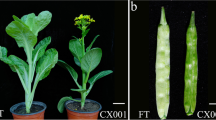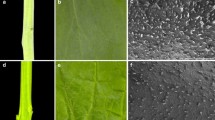Abstract
The great majority of terrestrial plants produce epicuticular wax that is used to protect plants from a variety of biotic and abiotic stresses. Cabbage epicuticular wax is a white crystalline compound of various lipids. Wax-less cabbage has the characteristics of lustrous green leaves and beautiful exterior, which facilitates the brilliant green cabbage breeding. CGL-3 is a spontaneous wax-less mutant identified from cabbage. Genetic analysis indicated that the waxy deficiency of the mutant was controlled by a single dominant gene. To clarify the mechanism of the waxy deficiency, fine-mapping and transcriptome analysis of the wax-less gene, BoGL-3, were carried out in this study. The result of fine mapping showed that the wax-less gene, BoGL-3, was delimited in a 33.5-kb interval which is between the flanking marker C08-98 and the end of chromosome 8. Two cDNA libraries, constructed with wax-less cabbage CGL-3 and the wild-type cabbage WT, were sequenced for screening of the target gene BoGL-3. A total of 8340 genes were identified with significant differential expression between CGL-3 and WT. Among these genes, 3187 were up-regulated and 5153 were down-regulated in CGL-3. With homologous analysis, four differential expressed genes related to wax metabolism were obtained. Among these four genes, only Bol018504 is located within the region of fine-mapping. Bol08504 is homologous to CER1, which encodes fatty acid hydroxylase and plays an important role in wax synthesis in Arabidopsis. However, there was no difference of Bol08504 sequence between CGL-3 and WT. We suggested that Bol018504 was regulated by BoGL-3. The suppression of Bol018504 leads to the reduction of wax. These findings will be helpful to reveal the mechanism of the wax metabolism in cabbage and develop lustrous green cabbage germplasm material.






Similar content being viewed by others
References
Aarts MG, Keijzer CJ, Stiekema WJ, Pereira A (1995) Molecular characterization of the CER1 gene of Arabidopsis involved in epicuticular wax biosynthesis and pollen fertility. Plant Cell 7:2115–2127
Beisson F, Li-Beisson Y, Pollard M (2012) Solving the puzzles of cutin and suberin polymer biosynthesis. Curr Opin Plant Biol 15:329–337
Benjamini Y, Hochberg Y (2000) On the adaptive control of the false discovery rate in multiple testing with independent statistics. J Educ Behav Stat 25:60–83
Bernard A, Joubès J (2013) Arabidopsis cuticular waxes: advances in synthesis, export and regulation. Prog Lipid Res 52:110–129
Bernard A, Domergue F, Pascal S, Jetter R, Renne C, Faure JD, Haslam RP, Napier JA, Lessire R, Joubès J (2012) Reconstitution of plant alkane biosynthesis in yeast demonstrates that Arabidopsis ECERIFERUM1 and ECERIFERUM3 are core components of a very-long-chain alkane synthesis complex. Plant Cell 24:3106–3118
Bonaventure G, Salas JJ, Pollard MR, Ohlrogge JB (2003) Disruption of the FATB gene in Arabidopsis demonstrates an essential role of saturated fatty acids in plant growth. Plant Cell 15:1020
Bourdenx B, Bernard A, Domergue F, Pascal S, Leger A, Roby D, Pervent M, Vile D, Haslam RP, Napier JA, Lessire R, Joubes J (2011) Overexpression of Arabidopsis ECERIFERUM1 promotes wax very-long-chain alkane biosynthesis and influences plant response to biotic and abiotic stresses. Plant Physiol 156:29–45
Burow GB, Franks CD, Acosta-Martinez V, Xin Z (2009) Molecular mapping and characterization of BLMC, a locus for profuse wax (bloom) and enhanced cuticular features of Sorghum (Sorghum bicolor (L.) Moench.). Theor Appl Genet 118:423–431
Conesa A, Götz S (2008) Blast2GO: a comprehensive suite for functional analysis in plant genomics. Int J Plant Genomics 2008:619832
Corpet F (1988) Multiple sequence alignment with hierarchical clustering. Nucleic Acids Res 16:10881–10890
Davidson AE, Liskova P, Evans CJ, Dudakova L, Nosková L, Pontikos N, Hartmannová H, Hodaňová K, Stránecký V, Kozmík Z (2016) Autosomal-dominant corneal endothelial dystrophies CHED1 and PPCD1 are allelic disorders caused by non-coding mutations in the promoter of OVOL2. Am J Hum Genet 98:75
Ding B, Mou F, Sun W, Chen S, Peng F, Bradshaw HD, Yuan YW (2017) A dominant-negative actin mutation alters corolla tube width and pollinator visitation in Mimulus lewisii. New Phytol 213:1936–1944
Grabherr MG, Haas BJ, Yassour M, Levin JZ, Thompson DA, Amit I, Adiconis X, Fan L, Raychowdhury R, Zeng Q (2011) Full-length transcriptome assembly from RNA-Seq data without a reference genome. Nat Biotechnol 29:644–652
Huang D, Feurtado JA, Smith MA et al (2017) Long noncoding miRNA gene represses wheat β-diketone waxes. Proc Natl Acad Sci USA 114:E3149–E3158
Jung KH, Han MJ, Lee D, Lee YS, Schreiber L, Franke R, Faust A, Yephremov A, Saedler H, Kim YW (2006) Wax-deficient anther1 is involved in cuticle and wax production in rice anther walls and is required for pollen development. Plant Cell 18:3015–3032
Kanehisa M, Goto S, Kawashima S, Okuno Y, Hattori M (2004) The KEGG resource for deciphering the genome. Nucleic Acids Res 32:277–280
Kato T (2010) Defects in dynamics and functions of actin filament in Arabidopsis caused by the dominant-negative actin fiz1-induced fragmentation of actin filament. Plant Cell Physiol 51:333–338
Kerstiens G (1996) Plant cuticles: an integrated functional approach. J Exp Bot 47:50–60
Koornneef M, Hanhart CJ, Thiel F (1989) A genetic and phenotypic description of eceriferum mutants in Arabidopsis thaliana. J Hered 80:118–122
Kunst L, Samuels AL (2003) Biosynthesis and secretion of plant cuticular wax. Prog Lipid Res 42:51–80
Kunst L, Samuels L (2009) Plant cuticles shine: advances in wax biosynthesis and export. Curr Opin Plant Biol 12:721–727
Lee SB, Suh MC (2015) Advances in the understanding of cuticular waxes in Arabidopsis thaliana and crop species. Plant Cell Rep 34:557–572
Li-Beisson Y, Shorrosh B, Beisson F, Andersson MX, Arondel V, Bates PD, Baud S, Bird D, Debono A, Durrett TP (2010) Acyl-lipid metabolism. Arabidopsis Book 11:133
Liu D, Tang J, Liu Z, Dong X, Zhuang M, Zhang Y, Lv H, Sun P, Liu Y, Li Z, Ye Z, Fang Z, Yang L (2017a) Cgl2 plays an essential role in cuticular wax biosynthesis in cabbage (Brassica oleracea L. var. capitata). BMC Plant Biol 17:223
Liu Z, Fang Z, Zhuang M, Zhang Y, Lv H, Liu Y, Li Z, Sun P, Tang J, Liu D (2017b) Fine-mapping and analysis of Cgl1, a gene conferring glossy trait in cabbage (Brassica oleracea L. var. capitata). Front Plant Sci 8:239
Mortazavi A, Williams BA, Mccue K, Schaeffer L, Wold B (2008) Mapping and quantifying mammalian transcriptomes by RNA-Seq. Nat Methods 5:621–628
Nishimura T, Yokota E, Wada T, Shimmen T, Okada K (2003) An Arabidopsis ACT2 dominant-negative mutation, which disturbs F-actin polymerization, reveals its distinctive function in root development. Plant Cell Physiol 44:1131–1140
Pu Y, Jie G, Guo Y, Liu T, Zhu L, Ping X, Yi B, Jing W, Tu J, Ma C (2013) A novel dominant glossy mutation causes suppression of wax biosynthesis pathway and deficiency of cuticular wax in Brassica napus. BMC Plant Biol 13:215
Rashotte AM, Jenks MA, Nguyen TD, Feldmann KA (1997) Epicuticular wax variation in ecotypes of Arabidopsis thaliana. Phytochemistry 45:251–255
Rowland O, Zheng H, Hepworth SR, Lam P, Jetter R, Kunst L (2006) CER4 encodes an alcohol-forming fatty acyl-coenzyme A reductase involved in cuticular wax production in Arabidopsis. Plant Physiol 142:866
Rowland O, Lee R, Franke R, Schreiber L, Kunst L (2007) The CER3 wax biosynthetic gene from Arabidopsis thaliana is allelic to WAX2/YRE/FLP1. FEBS Lett 581:3538–3544
Saghai-Maroof MA, Soliman KM, Jorgensen RA, Allard R (1984) Ribosomal DNA spacer-length polymorphisms in barley: Mendelian inheritance, chromosomal location, and population dynamics. Proc Natl Acad Sci USA 81:8014–8018
Suh MC, Samuels AL, Jetter R, Kunst L, Pollard M, Ohlrogge J, Beisson F (2005) Cuticular lipid composition, surface structure, and gene expression in Arabidopsis stem epidermis. Plant Physiol 139:1649–1665
Tang J, Liu D, Liu Z, Yang L, Fang Z, Liu Y, Zhuang M, Zhang Y, Honghao L, Dengxia YI (2015) Preliminary study of the characteristics of several glossy cabbage (Brassica oleracea var. capitate L.) mutants. Hortic Plant J 1:93–100
Todd J, Postbeittenmiller D, Jaworski JG (1999) KCS1 encodes a fatty acid elongase 3-ketoacyl-CoA synthase affecting wax biosynthesis in Arabidopsis thaliana. Plant J 17:119
Unger E, Parsons RL, Schmidt RJ et al (1993) Dominant negative mutants of Opaque2 suppress transactivation of a 22-kD Zein promoter by Opaque2 in Maize endosperm cells. Plant Cell 5:831–841
Xia Y, Nikolau BJ, Schnable PS (1996) Cloning and characterization of CER2, an Arabidopsis gene that affects cuticular wax accumulation. Plant Cell 8:1291–1304
Xiang-Li MU, Chao W, Shuai W (2013) Observation of ultra microstructure of wax-less mutant epicuticular wax on cabbage. China Veget 4:32–37
Xu SJ, Jiang PA, Wang ZW, Wang Y (2009) Crystal structures and chemical composition of leaf surface wax depositions on the desert moss Syntrichia caninervis. Biochem Syst Ecol 37:723–730
Zhang X, Liu Z, Wang P, Wang Q, Yang S, Feng H (2014) Fine mapping of Br Wax1, a gene controlling cuticular wax biosynthesis in Chinese cabbage (Brassica rapa L. ssp. pekinensis). Mol Breeding 32:867–874
Acknowledgements
This work was financially supported by grants from the National Key Research and Development Program (2017YFD0101804), National Natural Science Foundation of China (31672155), the Science and Technology Innovation Program of the Chinese Academy of Agricultural Sciences (CAAS-ASTIP-2013-IVFCAAS), National High Technology Research and Development Program of China (863 Program, 2012AA100101), the Key Projects in the National Science and Technology Pillar Program during the Twelfth Five-Year Plan Period (2012BAD02B01), the Modern Agro-Industry Technology Research System (CARS-25-B-01), and the Project of Science and Technology Commission of Beijing Municipality (Z141105002314020-1).
Author information
Authors and Affiliations
Corresponding author
Ethics declarations
Conflict of interest
The authors declare that they have no conflict of interest.
Ethical approval
This article does not contain any studies with human participants or animals performed by any of the authors.
Additional information
Communicated by Stefan Hohmann.
Publisher's Note
Springer Nature remains neutral with regard to jurisdictional claims in published maps and institutional affiliations.
Electronic supplementary material
Below is the link to the electronic supplementary material.
Fig. S1.
Statistics of gene ontology (TIFF 196 kb)
Fig. S2.
Sequence alignment of gDNA of Bol018504 between WT and CGL-3 (TIFF 461 kb)
Fig. S3.
Sequence alignment of cDNA of Bol018504 between WT and CGL-3 (TIFF 775 kb)
Fig. S4.
Sequence alignment of upstream of Bol018504 between WT and CGL-3 (TIFF 271 kb)
Fig. S5.
Sequence alignment of downstream of Bol018504 between WT and CGL-3 (TIFF 1423 kb)
Fig. S6.
Sequence alignment of gDNA of Bol018505 between WT and CGL-3 (TIFF 126 kb)
Fig. S7.
Sequence alignment of gDNA of Bol018506 between WT and CGL-3 (TIFF 173 kb)
Fig. S8.
Sequence alignment of gDNA of Bol018507 between WT and CGL-3 (TIFF 505 kb)
Fig. S9.
Sequence alignment of gDNA of Bol018508 between WT and CGL-3 (TIFF 158 kb)
Table S1.
SSR polymorphism primers obtained from scanning by parents and F1 (DOCX 22 kb)
Table S2.
Sequences of the primers for detecting candidate gene (DOCX 14 kb)
Table S3.
Gene annotation of candidate region (DOCX 17 kb)
Table S4.
Data filtering statistics analysis (DOCX 14 kb)
Table S5.
Statistics of different genes expression among groups (XLSX 5203 kb)
Table S6.
The significant KEGG pathways (XLSX 9 kb)
Table S7.
DEGs concerning wax biosynthesis (XLSX 20 kb)
Rights and permissions
About this article
Cite this article
Dong, X., Ji, J., Yang, L. et al. Fine-mapping and transcriptome analysis of BoGL-3, a wax-less gene in cabbage (Brassica oleracea L. var. capitata). Mol Genet Genomics 294, 1231–1239 (2019). https://doi.org/10.1007/s00438-019-01577-5
Received:
Accepted:
Published:
Issue Date:
DOI: https://doi.org/10.1007/s00438-019-01577-5




